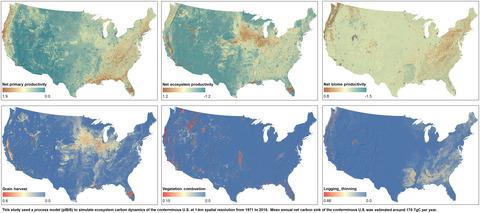当前位置:
X-MOL 学术
›
Glob. Change Biol.
›
论文详情
Our official English website, www.x-mol.net, welcomes your
feedback! (Note: you will need to create a separate account there.)
Critical land change information enhances the understanding of carbon balance in the United States.
Global Change Biology ( IF 10.8 ) Pub Date : 2020-03-11 , DOI: 10.1111/gcb.15079 Jinxun Liu 1 , Benjamin M Sleeter 1 , Zhiliang Zhu 1 , Thomas R Loveland 1 , Terry Sohl 1 , Stephen M Howard 1 , Carl H Key 1 , Todd Hawbaker 1 , Shuguang Liu 2 , Bradley Reed 1 , Mark A Cochrane 3 , Linda S Heath 4 , Hong Jiang 5 , David T Price 6 , Jing M Chen 7 , Decheng Zhou 8 , Norman B Bliss 1 , Tamara Wilson 1 , Jason Sherba 1 , Qiuan Zhu 9 , Yiqi Luo 10 , Benjamin Poulter 11
Global Change Biology ( IF 10.8 ) Pub Date : 2020-03-11 , DOI: 10.1111/gcb.15079 Jinxun Liu 1 , Benjamin M Sleeter 1 , Zhiliang Zhu 1 , Thomas R Loveland 1 , Terry Sohl 1 , Stephen M Howard 1 , Carl H Key 1 , Todd Hawbaker 1 , Shuguang Liu 2 , Bradley Reed 1 , Mark A Cochrane 3 , Linda S Heath 4 , Hong Jiang 5 , David T Price 6 , Jing M Chen 7 , Decheng Zhou 8 , Norman B Bliss 1 , Tamara Wilson 1 , Jason Sherba 1 , Qiuan Zhu 9 , Yiqi Luo 10 , Benjamin Poulter 11
Affiliation

|
Large‐scale terrestrial carbon (C) estimating studies using methods such as atmospheric inversion, biogeochemical modeling, and field inventories have produced different results. The goal of this study was to integrate fine‐scale processes including land use and land cover change into a large‐scale ecosystem framework. We analyzed the terrestrial C budget of the conterminous United States from 1971 to 2015 at 1‐km resolution using an enhanced dynamic global vegetation model and comprehensive land cover change data. Effects of atmospheric CO2 fertilization, nitrogen deposition, climate, wildland fire, harvest, and land use/land cover change (LUCC) were considered. We estimate annual C losses from cropland harvest, forest clearcut and thinning, fire, and LUCC were 436.8, 117.9, 10.5, and 10.4 TgC/year, respectively. C stored in ecosystems increased from 119,494 to 127,157 TgC between 1971 and 2015, indicating a mean annual net C sink of 170.3 TgC/year. Although ecosystem net primary production increased by approximately 12.3 TgC/year, most of it was offset by increased C loss from harvest and natural disturbance and increased ecosystem respiration related to forest aging. As a result, the strength of the overall ecosystem C sink did not increase over time. Our modeled results indicate the conterminous US C sink was about 30% smaller than previous modeling studies, but converged more closely with inventory data.
中文翻译:

重要的土地变化信息可增强对美国碳平衡的了解。
使用大气反演,生物地球化学模型和现场清单等方法进行的大规模陆地碳(C)估算研究产生了不同的结果。这项研究的目的是将包括土地利用和土地覆被变化在内的精细过程整合到一个大规模的生态系统框架中。我们使用增强的动态全球植被模型和综合的土地覆盖变化数据,以1 km的分辨率分析了美国本土1971年至2015年的C预算。大气CO 2的影响考虑了施肥,氮沉降,气候,荒地火灾,收成和土地利用/土地覆被变化(LUCC)。我们估计,每年因农田收割,森林砍伐和间伐,火灾和LUCC造成的碳损失分别为436.8、117.9、10.5和10.4 TgC /年。在1971年至2015年之间,生态系统中储存的C从119,494 TgC增加到127,157 TgC,这表明年均C净汇为170.3 TgC /年。尽管生态系统净初级生产力每年增加约12.3 TgC,但大部分被采伐和自然干扰造成的碳损失增加以及与森林老化相关的生态系统呼吸增加所抵消。结果,整个生态系统碳汇的强度没有随时间增加。我们的建模结果表明,当前的US C汇比以前的建模研究小了约30%,
更新日期:2020-03-11
中文翻译:

重要的土地变化信息可增强对美国碳平衡的了解。
使用大气反演,生物地球化学模型和现场清单等方法进行的大规模陆地碳(C)估算研究产生了不同的结果。这项研究的目的是将包括土地利用和土地覆被变化在内的精细过程整合到一个大规模的生态系统框架中。我们使用增强的动态全球植被模型和综合的土地覆盖变化数据,以1 km的分辨率分析了美国本土1971年至2015年的C预算。大气CO 2的影响考虑了施肥,氮沉降,气候,荒地火灾,收成和土地利用/土地覆被变化(LUCC)。我们估计,每年因农田收割,森林砍伐和间伐,火灾和LUCC造成的碳损失分别为436.8、117.9、10.5和10.4 TgC /年。在1971年至2015年之间,生态系统中储存的C从119,494 TgC增加到127,157 TgC,这表明年均C净汇为170.3 TgC /年。尽管生态系统净初级生产力每年增加约12.3 TgC,但大部分被采伐和自然干扰造成的碳损失增加以及与森林老化相关的生态系统呼吸增加所抵消。结果,整个生态系统碳汇的强度没有随时间增加。我们的建模结果表明,当前的US C汇比以前的建模研究小了约30%,











































 京公网安备 11010802027423号
京公网安备 11010802027423号